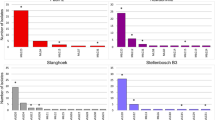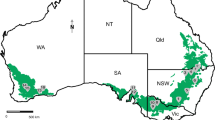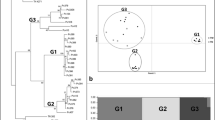Abstract
Sexual recombination and segregation in 18 ascospore progeny of Uncinula necator were analysed by mating type (Mat locus), RFLP and PCR markers. Progeny were analysed from a cross of parental isolates representing the genetically distinct phenetic Groups I (AHd2) and II (BNb2). A total of 27 markers was analysed, consisting of four single loci (Mat locus and three RFLP probes), 16 multi-loci (three multi-copy fingerprinting probes) and seven PCR loci. Novel hybrid genotypes were detected in 28% of the ascospore-derived progeny using the multi-copy RFLP probes, pUnl22-11 and pUnP27, and the PCR primers (CAC)5 and R1, confirming that recombination can occur between isolates representative of the two phenetic groups. This study provides evidence that out-crossing between isolates of U. necator generates novel genotypes and, as such, may have important implications for disease management practices, such as the durability of fungicides and host resistance.
Similar content being viewed by others
References
Brown JKM, Simpson CG (1994) Genetic analysis of DNA fingerprints and virulences in Erysiphe graminis f.sp. hordei. Current Genetics 26, 172–178.
Carter DA, Buck KW, Archer SA, Van der Less T, Shattock RC, Shaw DS (1999) The detection of nonhybrid, trisomie, and triploid offspring in sexual progeny of a mating of Phytophthora infestans. Fungal Genetics and Biology 26, 198–208.
Christiansen SK, Griese H (1990) Genetic analysis of the obligate parasitic barley powdery mildew fungus based on RFLP and virulence loci. Theoretical and Applied Genetics 79, 705–712.
Délye C, Laigret F, Corio-Costet MF (1997) RAPD analysis provides insight into the biology and epidemiology of Uncinula necator. Phytopathology 87, 670–677.
Doyle JJ, Doyle JL (1980) Isolation of plant DNA from fresh tissue. Focus 12, 13–15.
Evans KJ, Scott ES, Whisson DL (1997a) Heterothallism among South Australian clonal lines of Uncinula necator. Australasian Plant Pathology 26, 10–20.
Evans KJ, Whisson DL, Scott ES (1996) An experimental system for characterising isolates of Uncinula necator. Mycological Research 100, 675–680.
Evans KJ, Whisson DL, Stummer BE, Scott ES (1997b) DNA markers identify variation in Australian populations of Uncinula necator. Mycological Research 101, 923–932.
Förster H, Coffey MD (1990) Mating behaviour of Phytophthora parasitica, evidence for sexual recombination in oospores using DNA restriction fragment length polymorphisms as genetic markers. Experimental Mycology 14, 351–359.
Gadoury DM, Pearson RC (1991) Heterothallism and pathogenic specialization in Uncinula necator. Phytopathology 81, 1287–1293.
Gee LM, Stummer BE, Gadoury DM, Biggins LT, Scott ES (2000) Maturation of cleistothecia of Uncinula necator (powdery mildew) and release of ascospores in southern Australia. Australian Journal of Grape and Wine Research 6, 13–20.
Geistlinger J, Maqbools S, Kaiser WJ, Kahl G (1997) Detection of microsatellite fingerprint markers and their Mendelian inheritance in Ascochyta rabiei. Mycological Research 101, 1113–1121.
Magarey PA, Gadoury DM, Emmett RW, Biggins LT, Clark K, Wachtel MF, Wicks TJ, Seem RC (1997) Cleistothecia of Uncinula necator in Australia. Viticultural and Enological Science 52, 210–218.
McDonald BA, Miles J, Nelson LR, Pettway RE (1994) Genetic variability in nuclear DNA in field populations of Stagonospora nodorum. Phytopathology 84, 250–255.
Miazzi M, Natale P, Pollastro S, Faretra F (1997) Handling of the biotrophic pathogen Uncinula necator (Schw.) Burr, under laboratory conditions and observations on its mating system. Journal of Plant Pathology 78, 71–77.
Milgroom MG, Lipari SE, Powell WA (1992) DNA fingerprinting and analysis of population structure in the chestnut blight fungus, Cryphonectriaparasitica. Genetics 131, 297–306.
Pearson RC, Gadoury DM (1987) Cleistothecia, the source of primary inoculum for grape powdery mildew in New York. Phytopathology 77, 1509–1514.
Pearson RC, Gärtel W (1985) Occurrence of hyphae of Uncinula necator in buds of grapevine. Plant Disease 66, 149–151.
Peever TL, Milgroom MG (1994) Genetic structure of Pyrenophora teres populations determined with random amplified polymorphic DNA markers. Canadian Journal of Botany 72, 915–923.
Sambrook J, Fritsch EF, Maniatis T (Eds) (1989) ‘Molecular cloning, a laboratory manual (2nd edn)’. (Cold Spring Harbor Laboratory Press: Cold Spring Harbor, NY, USA)
Schneider S, Stummer B, Kassemeyer H-H, Blaich R, Scott E, Seem RC, Gadoury DM (1999) Mating of ascospore-and flag shoot-derived isolates of Uncinula necator. Phytopathology 89, Abstract S70.
Stummer BE, Zanker T, Scott ES, Whisson DL (2000) Genetic diversity in populations of Uncinula necator, comparison of RFLP- and PCR-based approaches. Mycological Research 104, 44–52.
Wicks T, Magarey PA, Emmett R (1985) First report of Uncinula necator cleistothecia on grapevines in Australia. Plant Disease 69, 727.
Author information
Authors and Affiliations
Corresponding author
Rights and permissions
About this article
Cite this article
Stummer, B.E., Scott, E.S. Detection of novel genotypes in progeny from a controlled cross between isolates of Uncinula necator belonging to distinct phenetic groups. Australasian Plant Pathology 32, 213–218 (2003). https://doi.org/10.1071/AP03002
Received:
Accepted:
Issue Date:
DOI: https://doi.org/10.1071/AP03002




